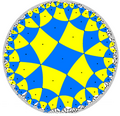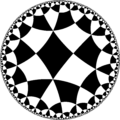Tetrahexagonal tiling
In geometry, the tetrahexagonal tiling is a uniform tiling of the hyperbolic plane. It has Schläfli symbol r{6,4}.
Constructions
There are for uniform constructions of this tiling, three of them as constructed by mirror removal from the [6,4] kaleidoscope. Removing the last mirror, [6,4,1+], gives [6,6], (*662). Removing the first mirror [1+,6,4], gives [(4,4,3)], (*443). Removing both mirror as [1+,6,4,1+], leaving [(3,∞,3,∞)] (*3232).
Symmetry
The dual tiling, called a rhombic tetrahexagonal tiling, with face configuration V4.6.4.6, and represents the fundamental domains of a quadrilateral kaleidoscope, orbifold (*3232), shown here in two different centered views. Adding a 2-fold rotation point in the center of each rhombi represents a (2*32) orbifold.
Related polyhedra and tiling
See also
References
- John H. Conway, Heidi Burgiel, Chaim Goodman-Strauss, The Symmetries of Things 2008,ISBN 978-1-56881-220-5 (Chapter 19, The Hyperbolic Archimedean Tessellations)
- "Chapter 10: Regular honeycombs in hyperbolic space". The Beauty of Geometry: Twelve Essays. Dover Publications. 1999. ISBN 0-486-40919-8. LCCN 99035678.



